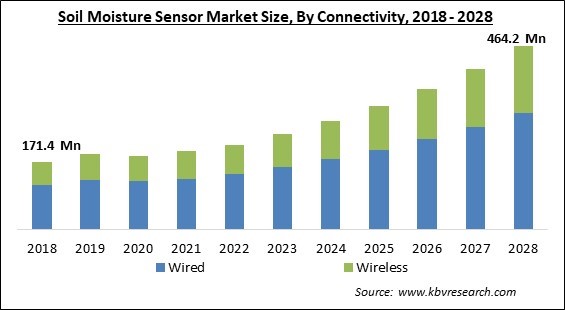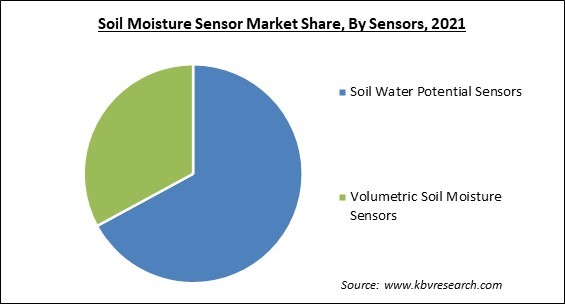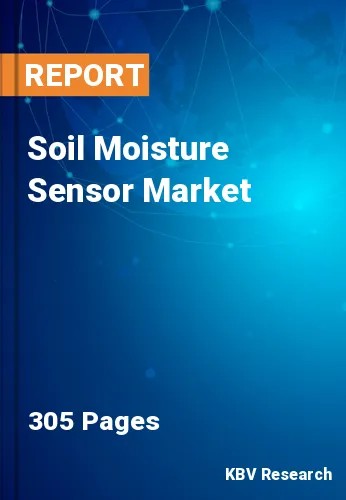The Global Soil Moisture Sensor Market size is expected to reach $464.2 Million by 2028, rising at a market growth of 13.7% CAGR during the forecast period.
The soil moisture sensor is a type of sensor used to measure the soil's volumetric water content. The direct gravimetric measurement of soil moisture requires elimination, drying, and sample weighting. These sensors quantify the volumetric water content indirectly with the use of other soil properties, such as dielectric constant, neutron interaction, electrical resistance, and moisture replacement.

Soil moisture sensors determine the soil's volumetric water content. The relationship between the obtained property and soil moisture should be calibrated and may change based on environmental conditions such as temperature, soil type, or electric conductivity. Reflected microwave radiation is impacted by soil moisture and is utilized in hydrology and agriculture for distant sensing.
Farmers and gardeners may utilize probing instruments that are mobile. Typically, soil moisture sensors refer to sensors that assess the volumetric water content of the soil. These sensors are commonly called soil water potential sensors and also include gypsum and tensiometers blocks. They detect water potential, another aspect of soil moisture.
The relationship between the computed property and soil moisture must be modified and may vary based on ecological parameters, such as temperature, soil type, and electric conductivity. The reflected microwave emission can be affected by soil moisture and is mostly employed in agriculture as well as remote sensing under hydrology.
Sensing, images, and remote monitoring are anticipated to be in high demand in the world after COVID-19. Several businesses within the equipment sector witnessed poor growth during the initial period of the pandemic. In spite of the pandemic, the demand for connected agriculture, as well as telematics, has increased. The COVID-19 pandemic can expedite the installation of Internet of Things-based devices for agricultural and non-agricultural applications. In the medium to long term, the proportion of connected agricultural devices is anticipated to increase in a promising manner. Eventually, the growth of the soil moisture sensor market is anticipated to gradually recover and increase significantly in the coming years.
Progressive farmers have demonstrated an interest in soil monitoring throughout a number of developed as well as developing countries. As it aids in achieving optimal crop quality and yields, soil monitoring is gaining widespread acceptance among farmers who engage in irrigation. Over-irrigation of a field results in the growth of a shallow root system, which impacts the nutrients that are washed away from the soil, thereby diminishing crop quality. Due to the rapidly expanding population of the world, which could result in food shortages, soil monitoring has assumed great significance.
One of the biggest factors that are contributing to the growth of the soil moisture sensor market is the high-cost savings and efficiency it offers. Soil monitoring enables farmers to save money on fertilizers, water bills, insecticides, and other inputs, thereby conserving resources. However, the price of reliable soil monitoring sensors is considerable, meaning growers must compromise between dependability and cost.
The spatial variability of soil is one of the primary problems impeding the growth of the soil monitoring market. Various fields use soil monitoring systems, devices, and equipment for various purposes; for instance, researchers use it to monitor surface run-off and movement of nutrient content, dissolved solutes, soil temperature, etc., while farm professionals use it to measure the amount and timing of irrigation needed for crops.

Based on Sensors, the Soil Moisture Sensor Market is bifurcated into Volumetric Soil Moisture Sensors (Capacitance, Probes, and Time Domain Transmissometry) and Soil Water Potential Sensors (Gypsum Blocks, Tensiometers, and Granular Matrix). In the soil water potential sensors type segment, the tensiometers segment garnered the biggest revenue share of the market. This type of sensor is widely used to measure the tension between water molecules and soil particles. The tensiometer functions as a root, while its ceramic tip communicates with the soil and emits water when it becomes dry.
On the basis of Connectivity, the Soil Moisture Sensor Market is divided into Wired and Wireless. In 2021, the wired sensors segment acquired the largest revenue share of the soil moisture sensor market. The growth of the segment is rapidly rising as a result of the fact that these are one of the most traditional types of sensors across the market. Wire-based sensors are the most prevalent in regular activities.
By Application, the Soil Moisture Sensor Market is segregated into Agriculture, Construction and Mining, Residential, Forestry, Landscaping and Ground Care, Research Studies, Sports, and Weather Forecasting. In 2021, the sports segment recorded a substantial revenue share of the soil moisture sensor market. In an effort to ensure and maintain a lush outfield, the sports market has expanded rapidly. For instance, sensors are widely utilized for golf course maintenance. Government investments in the improvement of sports grounds and the necessity for controlled grass growth on sports fields are primarily responsible for the segment's rise.
| Report Attribute | Details |
|---|---|
| Market size value in 2021 | USD 197.2 Million |
| Market size forecast in 2028 | USD 464.2 Billion |
| Base Year | 2021 |
| Historical Period | 2018 to 2020 |
| Forecast Period | 2022 to 2028 |
| Revenue Growth Rate | CAGR of 13.7% from 2022 to 2028 |
| Number of Pages | 305 |
| Number of Tables | 550 |
| Report coverage | Market Trends, Revenue Estimation and Forecast, Segmentation Analysis, Regional and Country Breakdown, Companies Strategic Developments, Company Profiling |
| Segments covered | Application, Connectivity, Sensors, Region |
| Country scope | US, Canada, Mexico, Germany, UK, France, Russia, Spain, Italy, China, Japan, India, South Korea, Singapore, Malaysia, Brazil, Argentina, UAE, Saudi Arabia, South Africa, Nigeria |
| Growth Drivers |
|
| Restraints |
|
Region-Wise, the Soil Moisture Sensor Market is analyzed across North America, Europe, Asia-Pacific, and LAMEA. In 2021, North America accounted for the largest revenue share of the soil moisture sensor market. The dominance is mostly attributable to the considerably higher adoption of sensors in the agriculture and sports markets. The United States is home to numerous producers of soil moisture sensors, including Campbell Scientific, Inc. and The Toro Company.
Free Valuable Insights: Global Soil Moisture Sensor Market size to reach USD 464.2 Billion by 2028
The market research report covers the analysis of key stake holders of the market. Key companies profiled in the report include Spectrum Technologies, Inc. (BAE Systems PLC), OTT HydroMet GmbH (Danaher Corporation), Acclima, Inc., Delta-T Devices Ltd., METER Group, Inc., SDEC France, Smartcultiva Corporation, Trellis, Inc., Vegetronix, Inc., and Stevens Water Monitoring Systems, Inc.
By Application
By Connectivity
By Sensors
By Geography
The global Soil Moisture Sensor Market size is expected to reach $464.2 Million by 2028.
An Increase In The Demand For Enhanced Farm Productivity In Order To Meet The Requirements Of The Growing Population are driving the market in coming years, however, Challenges In Monitoring Soil As A Result Of Its Spatial Variability restraints the growth of the market.
Spectrum Technologies, Inc. (BAE Systems PLC), OTT HydroMet GmbH (Danaher Corporation), Acclima, Inc., Delta-T Devices Ltd., METER Group, Inc., SDEC France, Smartcultiva Corporation, Trellis, Inc., Vegetronix, Inc., and Stevens Water Monitoring Systems, Inc.
The agriculture segment acquired maximum revenue share in the Global Soil Moisture Sensor Market by Application in 2021 thereby, achieving a market value of $203.3 Million by 2028.
The Soil Water Potential Sensors segment is leading the Global Soil Moisture Sensor Market by Sensors in 2021 thereby, achieving a market value of $305.6 Million by 2028.
The North America market dominated the Global Soil Moisture Sensor Market by Region in 2021 and would continue to be a dominant market till 2028; thereby, achieving a market value of $169 Million by 2028.
Our team of dedicated experts can provide you with attractive expansion opportunities for your business.

